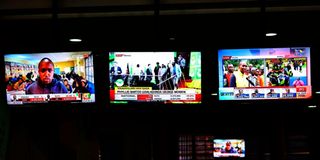Decision 2022: Media could have spared public election night fever

Screens displaying provisional results of the 2022 Kenyan presidential election by different TV stations at the Nation Centre.
What you need to know:
- After voting, people want to know who won and by how much within a reasonable time.
- Media outlets crunched their numbers, publishing different figures. That created confusion, and there was no indication who was winning.
- Our political culture is conspiracy-driven. There were premature claims of victory and misleading narratives of the tallying, which were amplified on social media.
The election night fever—presidential vote counting anxiety—that began on Tuesday evening after polls closed and came to a head on Wednesday night could have been avoided. It was a creation of the media and the electoral agency.
The IEBC uploaded on its portal Forms 34A containing voting returns from 46,229 polling stations and invited the media to download and tally them.
The caveat was, that only IEBC can formally announce the winner. The media, and the public, could make projections.
But tallying was a mammoth task. All the same, the various media houses set up their tallying centres.
They turned down a suggestion from IEBC to pool their resources. But the public expected the media to produce the winner—without delay. It didn’t happen.
After voting, people want to know who won and by how much within a reasonable time. If it takes too long, they become anxious and suspicious and fall prey to misinformation.
By yesterday afternoon, media outlets were crunching their numbers, publishing different figures. That created confusion, and there was no indication who was winning.
Conspiracies
Our political culture is conspiracy-driven. There were premature claims of victory and misleading narratives of the tallying, which were amplified on social media.
This was dangerous because those said to have won may not ultimately win, setting the stage for tension and conflict. It may also have damaged the public trust in IEBC and the election, to say nothing of the media.
The media and IEBC should have warned the public in good time on how the tallying would work. They should have cautioned them to be patient as that would take time.
The media ought to explain, in advance, the tallying and set reasonable expectations.
They should have made clear the possibility that counting the votes by downloading tens of thousands of Forms 34A would take a long and the final tally could not be realised in a night or two.
They should have explained continually the realities of downloading Forms 34A and crunching the numbers.
Different numbers
But the media did explain the different numbers. In an article on Wednesday by Patrick Lang’at, he explained why TV stations were displaying different tallies.
The print Daily Nation ran the explainer “Why media are displaying varying tallies of election results” the following day (August 11).
The explanation was that the figures differed depending on the speed of processing the data and the manpower deployed.
There was also the randomness with which the IEBC uploaded Forms 34A and how a media house chose what to download and tally.
Had that information been provided at the start of the tallying and the public continually warned that crunching the numbers was a long and arduous task, there would have been less anxiety and suspicion.
The Media Council of Kenya, concerned about the public apprehension over the displaying of varying figures, issued a public statement.
“The MCK is in consultation with media owners and editors to find an urgent solution to this to ensure Kenyans receive synchronised results,” chief executive David Omwoyo said in a statement on Wednesday.
The synchronisation never came to be.
Some people tried to overcome the problem by flipping from station to station.
But let me leave you with this advice veteran journalist Mohamed Warsama gave on Wednesday: “Both William Ruto and Raila Odinga are neck and neck at 8.40 am with Ruto having 1.29 million votes and Raila 1.285 million. Things will get exciting when each garners 3 million and they head for the next 3 million. Whoever polls 6.5 million of the over 12 mill (sic) total will be deemed the winner. So go about your business for now without any worry.
“Just keep an eye on the updates of the tally. When they clock 5.5 million start taking precautions, including stocking up on food, water, and medication. When the tally is nearing 6 million, it is wiser not to go out at all.”
The Public Editor is an independent news ombudsman who handles readers’ complaints on editorial matters including accuracy and journalistic standards. Email: [email protected]. Call or text 0721989264





